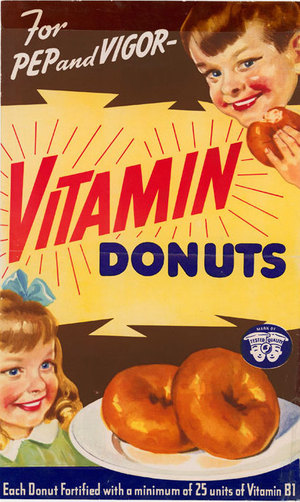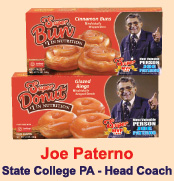AARP Hearing Center
The Donut Diet
By Bill Newcott, June 24, 2011 02:06 PM

Eat too many donuts, of course, and you'll just get big. But if you eat the right kind of donuts, in moderation, you'll end up big...and strong!
At least, that's the hope behind cutting-edge donut technology.
Here in Washington, D.C. there's a current exhibition at the National Archives about the government's role in promoting good nutrition. The exhibit's subway billboards get a lot of mileage out of a seemingly outrageous 1940s ad campaign promoting "Vitamin Donuts" for "Pep and Vigor." Two rosy-cheeked kids, who may as well be named Pep and Vigor, flank a plate of donuts (their eyes a bit wild, perhaps from sugar overload). Each donut, the ad reads, is "fortified with a minimum of 25 units of Vitamin B1." B1 is also known as Thiamine, which, ironically enough, is thought to be missing in people with diabetes.
"Hah!" snort the commuters, gazing at the ad and gently patting the cut carrots and celery sticks in their briefcases. "How foolish people were before Whole Foods."
Well, I hate to see donuts getting such a bad rap; we are old friends, and we've been through a lot together. So I did a little research and discovered that, well, donuts aren't good for you at all. In fact, the very, very best standard-issue donuts health-wise are glazed donuts, which will provide you with 8 percent of your daily iron requirement and 13 percent of your daily calcium requirement (according to fatsecret.com). In one sense, that's good news, because just one donut provides me with only 25 percent of my daily donut requirement, and if I eat enough of them, I'll have more iron in me than the Pulaski Skyway. But donuts, of course, have lots of other stuff that isn't quite as good for me (enough grease, for example, to maintain the drive shaft of a 1955 Chevy Bel-Air).
But then I discovered that the oddball ad from the 1940s wasn't so far off the mark-there are people out there who, when they look at America's runaway donut consumption, have decided "If you can't beat them, join 'em." Donut technology, it appears, has created if not a donut that's a health food, at least a donut that makes a meager attempt to be nice.
I speak, of course, about the Super Donut, which according to the company website "starts with high quality ingredients, all natural flavors and colors, and no preservatives" and mix in something they call Nutridough, "a unique and special blend of minerals, vitamins, and protein."
But the most interesting thing about Super Donut is its pedigree: Remember the great Pittsburgh Steelers running back Franco Harris? Well, Harris had to study somethingwhile he

was at Penn State in the early 70s, so he took classes in food science. And when his football days were done, in 1990 he started Super Foods specifically , he told the Houston Chronicle, because he was tired of people "demonizing the doughnut (which raises the eternal question: is it "donut" or "doughnut?")."
In any case, the rest is donut history. Harris likes to have his sports world buddies appear on the frozen Super Donut boxes-over the years they've featured Pittsburgh Pirates shortstop Jack Wilson, Pittsburgh Steelers receiver Hines Ward, and Penn State coach Joe Paterno (Hey, maybe it's donuts that are keeping that guy alive!).

One more diet tip: Save calories by eating donuts with bigger holes.































































